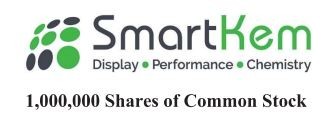The information in this preliminary prospectus is not complete and may be changed. The selling stockholders may not sell these securities pursuant to this prospectus until the registration statement filed with the Securities and Exchange Commission is effective. This preliminary prospectus is not an offer to sell these securities and is not soliciting offers to buy these securities in any jurisdiction where the offer or sale is not permitted.
SUBJECT TO COMPLETION, DATED APRIL 7, 2022
PRELIMINARY PROSPECTUS

This preliminary prospectus relates to the sale or other disposition by the selling stockholders identified herein of up to 1,000,000 shares of common stock, par value $0.0001 per share, of SmartKem, Inc. that were issued to the selling stockholders in a private placement that closed on January 27, 2022.
We will not receive any proceeds from the sale or other disposition of the shares of our common stock by the selling stockholders. The selling stockholders may sell or otherwise dispose of the shares of our common stock offered by this prospectus from time to time through the means described in this prospectus under the caption “Plan of Distribution”. For a list of the selling stockholders, see the section entitled “Selling Stockholders” on page 71 of this prospectus. We have borne and will continue to bear the costs relating to the registration of these shares.
Our common stock is quoted on the OTC Market Group’s OTCQB® Market quotation system under the ticker symbol “SMTK.” On April 4, 2022, the average of the bid and ask prices of our common stock was $3.50 per share.
We may amend or supplement this prospectus from time to time by filing amendments or supplements as required. You should read the entire prospectus and any amendments or supplements carefully before you make your investment decision.
We are an “emerging growth company” and a “smaller reporting company” as defined under the federal securities laws and, as such, are eligible for reduced public company reporting requirements. See “Prospectus Summary — Implications of Being an Emerging Growth Company and a Smaller Reporting Company”.
Investing in our common stock involves a high degree of risk. Before making an investment decision, please read “Risk Factors” on page 10 of this prospectus.
Neither the Securities and Exchange Commission nor any state securities commission has approved or disapproved of these securities or determined if this prospectus is truthful or complete. Any representation to the contrary is a criminal offense.
The date of this prospectus is , 2022.